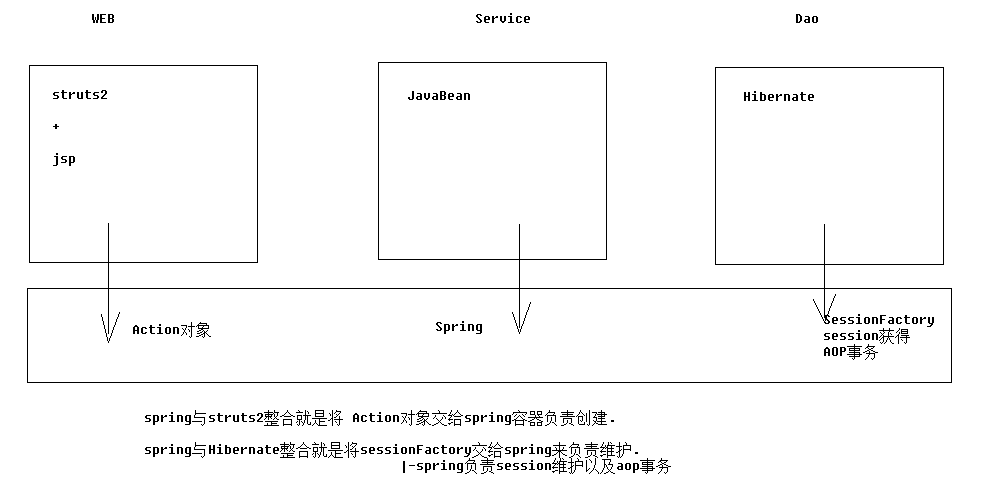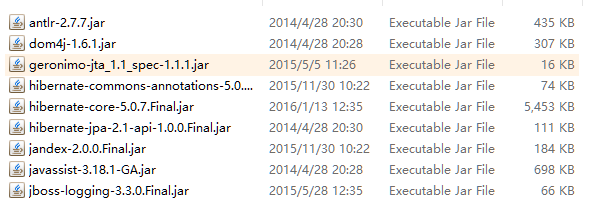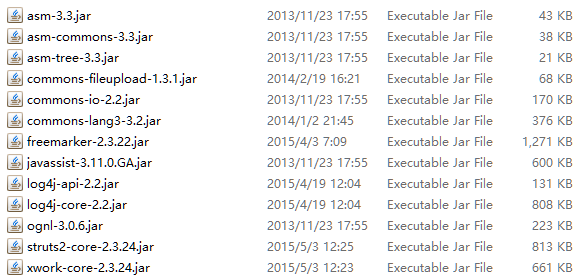三大框架架构(整合原理)

步骤1:导包
Hibernate包
1、Hibernate包,hibernate/lib/required

2、hibernate/lib/jpa | java persist api java的持久化规范(接口)

3、数据库驱动

Struts2包
1、struts2包

注意:javassist-3.18.1-GA.jar包与hibernate中的重复,删掉版本低的那个。
2、struts整合spring插件包
注意:这个包一旦导入,那么struts2在启动时就会寻找spring容器.找不到将会抛出异常

Spring包
1、spring包(基本:4+2), core|beans|context|expression|logging|log4j
2、spring包(整合web:web包),spring-web
3、spring包(整合aop:4个),spring-aop|spring-aspect|aop联盟|aopweaving
4、spring包(整合Hibernate和事务:4个),spring-jdbc|spring-tx|c3p0|spring-orm
5、spring包(junit4测试:test包 ),spring-test
标签库
standard.jar以及jstl-1.2.jar
步骤2:单独配置spring容器
1、在src目录下创建配置文件applicationContext.xml,并导入约束(4个),beans|context|aop|tx,嫌导入麻烦的话,直接copy下面模板即可。
<?xml version="1.0" encoding="UTF-8"?> <beans xmlns:xsi="http://www.w3.org/2001/XMLSchema-instance" xmlns="http://www.springframework.org/schema/beans" xmlns:context="http://www.springframework.org/schema/context" xmlns:aop="http://www.springframework.org/schema/aop" xmlns:tx="http://www.springframework.org/schema/tx" xsi:schemaLocation="http://www.springframework.org/schema/beans http://www.springframework.org/schema/beans/spring-beans-4.2.xsd http://www.springframework.org/schema/context http://www.springframework.org/schema/context/spring-context-4.2.xsd http://www.springframework.org/schema/aop http://www.springframework.org/schema/aop/spring-aop-4.2.xsd http://www.springframework.org/schema/tx http://www.springframework.org/schema/tx/spring-tx-4.2.xsd "> </beans>
2、在web.xml中配置spring随项目启动
<?xml version="1.0" encoding="UTF-8"?> <web-app xmlns="http://xmlns.jcp.org/xml/ns/javaee" xmlns:xsi="http://www.w3.org/2001/XMLSchema-instance" xsi:schemaLocation="http://xmlns.jcp.org/xml/ns/javaee http://xmlns.jcp.org/xml/ns/javaee/web-app_3_1.xsd" version="3.1"> <!--让spring随web的启动而创建--> <listener> <listener-class>org.springframework.web.context.ContextLoaderListener</listener-class> </listener> <!--配置spring配置文件位置--> <context-param> <param-name>contextConfigLocation</param-name> <param-value>classpath:applicationContext.xml</param-value> </context-param> </web-app>
步骤3:单独配置Struts2
1、配置struts2主配置文件
<?xml version="1.0" encoding="UTF-8"?> <!DOCTYPE struts PUBLIC "-//Apache Software Foundation//DTD Struts Configuration 2.3//EN" "http://struts.apache.org/dtds/struts-2.3.dtd"> <struts> <package name="crm" namespace="/" extends="struts-default"> <action name="UserAction_*" class="com.yyb.action.UserAction" > <result name="success">index.jsp</result> </action> </package> </struts>
2、在web.xml中配置struts2核心过滤器到web.xml
<!--配置struts2核心过滤器--> <filter> <filter-name>Struts2</filter-name> <filter-class>org.apache.struts2.dispatcher.ng.filter.StrutsPrepareAndExecuteFilter</filter-class> </filter> <filter-mapping> <filter-name>Struts2</filter-name> <url-pattern>/*</url-pattern> </filter-mapping>
步骤4:struts2与spring整合
1、导入关键包:struts2-spring-plugin-2.3.24.jar,前面已导入。
2、在struts.xml中配置常量
<?xml version="1.0" encoding="UTF-8"?> <!DOCTYPE struts PUBLIC "-//Apache Software Foundation//DTD Struts Configuration 2.3//EN" "http://struts.apache.org/dtds/struts-2.3.dtd"> <struts> <!-- # struts.objectFactory = spring 将action的创建交给spring容器 struts.objectFactory.spring.autoWire = name spring负责装配Action依赖属性,不用手动陪值 --> <constant name="struts.objectFactory" value="spring"></constant> <package name="crm" namespace="/" extends="struts-default"> <action name="UserAction_*" class="com.yyb.action.UserAction" method="{1}"> <result name="success">index.jsp</result> </action> </package> </struts>
3、整合方案1(不推荐):struts2自己创建action,spring负责组装依赖属性,就是在现有的基础上什么都不做。
整合方案2:spring负责创建action以及组装.
<!-- 整合方案2:class属性上填写spring中action对象的BeanName 完全由spring管理action生命周期,包括Action的创建 注意:需要手动组装依赖属性 --> <action name="UserAction_*" class="userAction" method="{1}" > </action>
applicationContext.xml配置如下:
<bean name="userAction" class="com.yyb.action.UserAction" scope="prototype"> <property name="userService" ref="userService"></property> </bean> <bean name="userService" class="com.yyb.service.UserServiceimpl"></bean>
步骤5:单独配置Hibernate
1、导入实体类&orm元数据

2、配置主配置文件hibernate.cfg.xml
<?xml version='1.0' encoding='utf-8'?> <!DOCTYPE hibernate-configuration PUBLIC "-//Hibernate/Hibernate Configuration DTD//EN" "http://www.hibernate.org/dtd/hibernate-configuration-3.0.dtd"> <hibernate-configuration> <session-factory> <!-- 数据库驱动 --> <property name="hibernate.connection.driver_class">com.mysql.jdbc.Driver</property> <!-- 数据库url --> <property name="hibernate.connection.url">jdbc:mysql://localhost:3306/hibernate_crm</property> <!-- 数据库连接用户名 --> <property name="hibernate.connection.username">root</property> <!-- 数据库连接密码 --> <property name="hibernate.connection.password">123456</property> <property name="hibernate.dialect">org.hibernate.dialect.MySQLDialect</property> <!-- 将hibernate生成的sql语句打印到控制台 --> <property name="hibernate.show_sql">true</property> <!-- 将hibernate生成的sql语句格式化(语法缩进) --> <property name="hibernate.format_sql">true</property> <property name="hibernate.hbm2ddl.auto">update</property> <mapping class="com.yyb.domain.Customer"/> <mapping resource="com/yyb/domain/Customer.hbm.xml"/> <mapping resource="com/yyb/domain/LinkMan.hbm.xml"/> <mapping resource="com/yyb/domain/User.hbm.xml"/> </session-factory> </hibernate-configuration>
步骤6:spring整合hibernate
整合原理:将sessionFactory对象交给spring容器管理,在spring中配置sessionFactory
配置方案一:仍然使用Hibernate.cfg.xml中的配置信息(不推荐)
<!--将sessionFactory配置到spring容器中--> <bean name="sessionFactory" class="org.springframework.orm.hibernate5.LocalSessionFactoryBean"> <property name="configLocation" value="classpath:hibernate.cfg.xml"></property> </bean>
配置方案二:不使用Hibernate.cfg.xml中的配置信息,在applicationContext.xml中进行如下配置:
<!-- 加载配置方案2:在spring配置中放置hibernate配置信息 --> <bean name="sessionFactory" class="org.springframework.orm.hibernate5.LocalSessionFactoryBean"> <!-- 配置hibernate基本信息 --> <property name="hibernateProperties"> <props> <!-- 必选配置 --> <prop key="hibernate.connection.driver_class">com.mysql.jdbc.Driver</prop> <prop key="hibernate.connection.url">jdbc:mysql:///crm_32</prop> <prop key="hibernate.connection.username">root</prop> <prop key="hibernate.connection.password">1234</prop> <prop key="hibernate.dialect">org.hibernate.dialect.MySQLDialect</prop> <!-- 可选配置 --> <prop key="hibernate.show_sql">true</prop> <prop key="hibernate.format_sql">true</prop> <prop key="hibernate.hbm2ddl.auto">update</prop> </props> </property> <!-- 引入orm元数据,指定orm元数据所在的包路径,spring会自动读取包中的所有配置 --> <property name="mappingDirectoryLocations" value="classpath:com/yyb/domain"></property> </bean>
spring整合c3p0连接池
1、配置db.properties
jdbc.jdbcUrl=jdbc:mysql:///crm
jdbc.driverClass=com.mysql.jdbc.Driver
jdbc.user=root
jdbc.password=123456
2、配置连接池
<!-- 读取db.properties文件 --> <context:property-placeholder location="classpath:db.properties" /> <!-- 配置c3p0连接池 --> <bean name="dataSource" class="com.mchange.v2.c3p0.ComboPooledDataSource" > <property name="jdbcUrl" value="${jdbc.jdbcUrl}" ></property> <property name="driverClass" value="${jdbc.driverClass}" ></property> <property name="user" value="${jdbc.user}" ></property> <property name="password" value="${jdbc.password}" ></property> </bean>
3、将连接池注入到sessionFactory
<!-- 加载配置方案2:在spring配置中放置hibernate配置信息 --> <bean name="sessionFactory" class="org.springframework.orm.hibernate5.LocalSessionFactoryBean"> <!-- 将连接池注入到sessionFactory, hibernate会通过连接池获得连接 --> <property name="dataSource" ref="dataSource"></property> <!-- 配置hibernate基本信息 --> <property name="hibernateProperties"> <props> <prop key="hibernate.dialect">org.hibernate.dialect.MySQLDialect</prop> <!-- 可选配置 --> <prop key="hibernate.show_sql">true</prop> <prop key="hibernate.format_sql">true</prop> <prop key="hibernate.hbm2ddl.auto">update</prop> </props> </property> <!-- 引入orm元数据,指定orm元数据所在的包路径,spring会自动读取包中的所有配置 --> <property name="mappingDirectoryLocations" value="classpath:com/yyb/domain"></property> </bean>
步骤7、spring整合hibernate环境操作数据库
Dao类创建:继承HibernateDaoSupport
package com.yyb.dao; import com.yyb.domain.User; import org.hibernate.HibernateException; import org.hibernate.Query; import org.hibernate.Session; import org.hibernate.criterion.DetachedCriteria; import org.hibernate.criterion.Restrictions; import org.springframework.orm.hibernate5.HibernateCallback; import org.springframework.orm.hibernate5.support.HibernateDaoSupport; import java.util.List; /** * Created by Administrator on 2017/8/17. */ public class UserDaoImpl extends HibernateDaoSupport implements UserDao { public User getUserByUserCode(String userCode) { return getHibernateTemplate().execute(new HibernateCallback<User>() { @Override public User doInHibernate(Session session) throws HibernateException { String hql = "from User where user_code=? "; Query query = session.createQuery(hql); query.setParameter(0, userCode); User user = (User) query.uniqueResult(); return user; } }); //DetachedCriteria detachedCriteria = DetachedCriteria.forClass(User.class); //detachedCriteria.add(Restrictions.eq("user_code",userCode)); //List<User> byCriteria = (List<User>) getHibernateTemplate().findByCriteria(detachedCriteria); //if(byCriteria!=null && byCriteria.size()>0){ // return byCriteria.get(0); //} //return null; } }
在applicationContext.xml中的配置如下:
<bean name="userDao" class="com.yyb.dao.UserDaoImpl"> <property name="sessionFactory" ref="sessionFactory"></property> </bean>
步骤8:spring的aop事务
1、配置核心事务管理器
<!--配置核心事务管理器--> <bean name="transactionManager" class="org.springframework.orm.hibernate5.HibernateTransactionManager"> <property name="sessionFactory" ref="sessionFactory"></property> </bean>
2、方式一:xml配置aop事务
<!-- 配置通知 --> <tx:advice id="txAdvice" transaction-manager="transactionManager" > <tx:attributes> <tx:method name="save*" isolation="REPEATABLE_READ" propagation="REQUIRED" read-only="false" /> <tx:method name="persist*" isolation="REPEATABLE_READ" propagation="REQUIRED" read-only="false" /> <tx:method name="update*" isolation="REPEATABLE_READ" propagation="REQUIRED" read-only="false" /> <tx:method name="modify*" isolation="REPEATABLE_READ" propagation="REQUIRED" read-only="false" /> <tx:method name="delete*" isolation="REPEATABLE_READ" propagation="REQUIRED" read-only="false" /> <tx:method name="remove*" isolation="REPEATABLE_READ" propagation="REQUIRED" read-only="false" /> <tx:method name="get*" isolation="REPEATABLE_READ" propagation="REQUIRED" read-only="true" /> <tx:method name="find*" isolation="REPEATABLE_READ" propagation="REQUIRED" read-only="true" /> </tx:attributes> </tx:advice> <!-- 配置将通知织入目标对象 配置切点、配置切面 --> <aop:config> <aop:pointcut expression="execution(* com.yyb.service.*ServiceImpl.*(..))" id="txPc"/> <aop:advisor advice-ref="txAdvice" pointcut-ref="txPc" /> </aop:config>
方式二:注解配置aop事务
<!--开启注解事务--> <tx:annotation-driven/>
在类上或者方法上添加注解即可
@Transactional(isolation = Isolation.DEFAULT,propagation = Propagation.REQUIRED,readOnly = false)
步骤9:扩大session的作用范围
为了避免使用懒加载时出现no-session问题.需要扩大session的作用范围,在web.xml中配置filter即可。
<filter> <filter-name>openSessionInViewFilter</filter-name> <filter-class>org.springframework.orm.hibernate5.support.OpenSessionInViewFilter</filter-class> </filter> <filter-mapping> <filter-name>openSessionInViewFilter</filter-name> <url-pattern>/*</url-pattern> </filter-mapping>
注意: 任何filter一定要在struts的filter之前调用
整合到这里终于结束了。源码下载